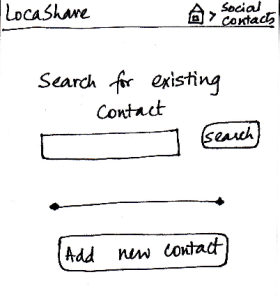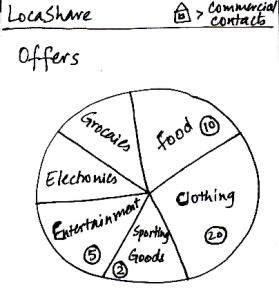 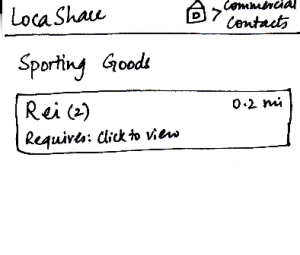
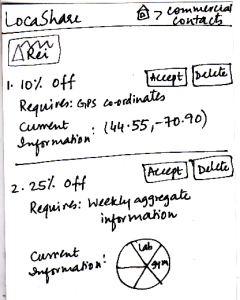 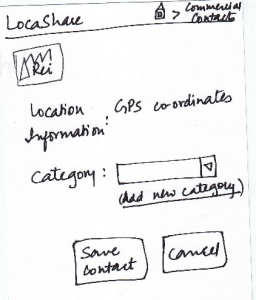
| Joe starts from the home screen and clicks
on the tab “Commercial Contacts”. He is
then taken to the screen shown here that can
be considered the “Home Screen” to handle
his commercial contacts. Here, he can view
various categories of products on a wheel.
This visual representation helps him view
various categories in a quick glance. Tiny
numbers enclosed in circles indicate the
number of offers by merchants/stores
belonging to that category.
Since Joe is at
a ski resort and wants to buy some gear,
he selects the wedge titled “Sporting Goods” .
He and is then taken to the next screen that shows
him the list of stores selling sporting goods
and having offers. Here, Rei happens to be
the store offering the two discounts in this
category. Since the two offers require different
location information (either in type or amount),
the actual location value is not displayed here.
<ac:structured-macro ac:name="unmigrated-wiki-markup" ac:schema-version="1" ac:macro-id="50ecc68e-9d07-4b42-9c0f-5c855d18d8ab"><ac:plain-text-body><![CDATA[[Note: you can view the sketch in the “Home
]]></ac:plain-text-body></ac:structured-macro>
screen” section to see an example of the
location information displayed below the store
names]. The distance from his current location
to Rei is also displayed (0.2 mi). Once he clicks
on the region, he is taken to the next screen
where he can see the two offers. Here we see
that Rei is offering a 10% off in exchange for raw
GPS coordinates. By default this would mean
GPS coordinates in that state. We display Joe’s
current GPS lat/long coordinates to help him
visualize the exact information he will be sharing.
The second offer involves a 25% discount in
exchange for a weekly aggregate information
. This means that LocaShare will aggregate
Joe’s information into meaningful chunks and
share them with Rei. In both cases, Joe can
He can then click on the company providing the offers and see the details of the offers. To help Joe understand the exact information he would be sharing, LocaShare displays his
current information as an example.
Joe can choose to accept or delete the offer by pressing
the “Accept” or “Delete” buttons respectively.
If he returns to the previous screen, these offers
do not disappear from the screen and will be
shown to him the next time he views the “Home
Screen” for commercial contacts. Suppose that
Joe decides to take Rei up on the first offer. He
would now see the following screen that summarizes
the information that Rei will receive and gives Joe to
add Rei to a category (in case he wants it to be
displayed in another category, or create a new category
for this merchant/store). He can then
Once he accepts an offer, he
would see a summary of the information he is about to share with Rei on the screen. He can choose to create a category in which to save Rei as a
contact. He finishes the process by pressing the “Save Contact” button or cancel
the offer by clicking “Cancel”. If he clicks on “Cancel”,
he will be taken back to the “Home Screen” for
commercial contacts.
| Pros:
The numbers do not make sense as they are not labeled or defined on the screen.
Cons:
| Pros:
Have to go through four screens to establish the commercial contact relationship.
Cons:
| Pros:
If you over-share
information, the only way
to cancel that is by deleting
the contact relationship. Not very efficient in that respect.
Cons:
| Pros:
Options and controls are clearly visible.
Cons:
|




